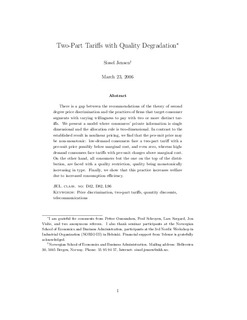| dc.contributor.author | Jensen, Sissel | |
| dc.date.accessioned | 2006-07-11T10:27:09Z | |
| dc.date.available | 2006-07-11T10:27:09Z | |
| dc.date.issued | 2006-03 | |
| dc.identifier.issn | 0804-6824 | |
| dc.identifier.uri | http://hdl.handle.net/11250/162706 | |
| dc.description.abstract | There is a gap between the recommendations of the theory of second
degree price discrimination and the practices of firms that target consumer
segments with varying willingness to pay with two or more distinct tar-
iffs. We present a model where consumers’ private information is single
dimensional and the allocation rule is two-dimensional. In contrast to the
established result in nonlinear pricing, we find that the per-unit price may
be non-monotonic: low-demand consumers face a two-part tariff with a
per-unit price possibly below marginal cost, and even zero, whereas high-
demand consumers face tariffs with per-unit charges above marginal cost.
On the other hand, all consumers but the one on the top of the distri-
bution, are faced with a quality restriction, quality being monotonically
increasing in type. Finally, we show that this practice increases welfare due to increased consumption efficiency. | en |
| dc.format.extent | 384174 bytes | |
| dc.format.mimetype | application/pdf | |
| dc.language.iso | eng | en |
| dc.publisher | Norwegian School of Economics and Business Administration. Department of Economics | en |
| dc.relation.ispartofseries | Discussion paper | en |
| dc.relation.ispartofseries | 2006:14 | en |
| dc.subject | price discrimination | en |
| dc.subject | two-part tariffs | en |
| dc.subject | quantity discounts | en |
| dc.subject | telecommunications | en |
| dc.title | Two-part tariffs with quality degradation | en |
| dc.type | Working paper | en |
